In today’s lesson, you’ll learn how to strategize and discover exactly what you should be creating content *on* in order to grow the traffic to your website.
It starts with keyword research.
Keyword research is the practice of identifying good opportunities to formulate your SEO strategy around.
It’s how you identify the average number of people who make a specific search each month, and how much competition there is to rank on page 1 for it.
The sweet spot is identifying terms with both a high monthly search volume and a low level of difficulty.
Example:
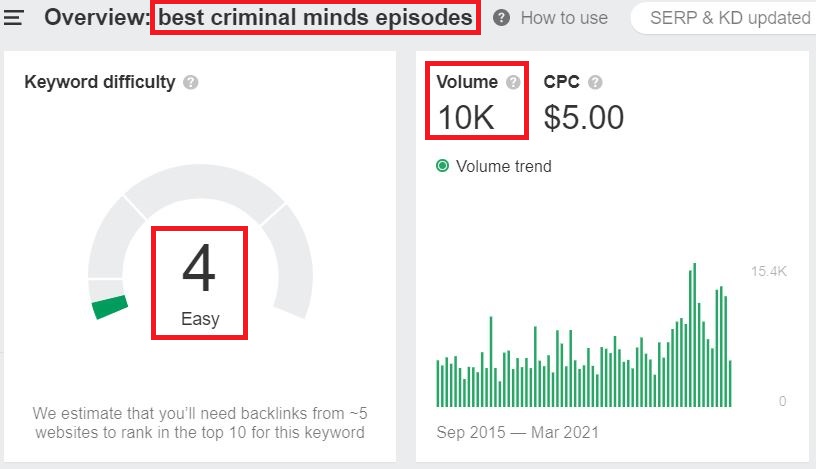
For some reason, most people just haven’t gotten around to learning this yet, despite how important it is.
By the end of this lesson, you’ll have an inherent advantage over 80% of your competition, and you’ll never look at another article the same way again.
How Blogs Get Traffic
The following data is a snapshot of the site thecookierookie.com for February 2023.

The first numbers to look at right now are the organic traffic (791k!), and traffic value ($903k!)
This is for one month, people.
That means that in February 2023 alone, this site had 791,000 visitors, and that traffic was valued at $903,000!
How does one site get so much traffic?
It’s because it’s full of helpful articles like this:

This isn’t a revolutionary article. I mean, it’s about how to make homemade dog treats.
Imagine if you could write an article about how to make freaking DOG TREATS that drove 47,600 people to visit it, and be valued at $110,000 monthly!
This is how you become rich. If you’ve got a product, ebook, course, or partnerships with companies paying to advertise, sites like thecookierookie.com get 791,000 eyeballs consistently every month for free.
That’s valuable real estate.
If even 1 percent of that traffic made a purchase, that’s an ongoing 7,910 sales per month!
Create Content That People Are Already Looking For
Far too often, website owners charge into writing articles, put tons of effort into them, and then… crickets.
What gives? Where are all the readers? Where’s that traffic that they were expecting?
“They made it sound so easy, damnit!”
There could be a lot of things wrong. But the first thing to look at is whether people are searching for that information in the first place.
It won’t matter if you’ve spent a hundred hours writing the best article the world has ever seen if it’s on a topic that nobody is looking for.
Remember the first lesson: People search when they have a problem and are looking for a solution.
It doesn’t matter how great your article on “alligator socks” is if nobody is searching for them.
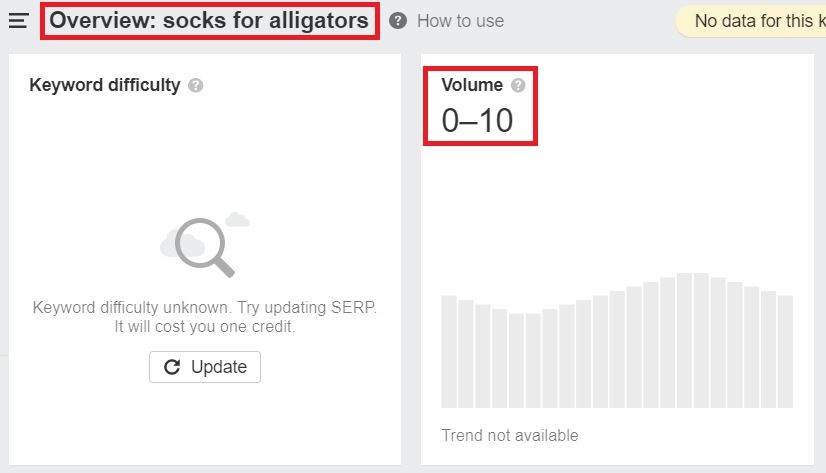
The one exception:
If you know your existing audience intimately and are certain of an article they’d benefit from reading, write it anyway and share it as much as you can – even if the data doesn’t show demand for it.
Maybe people just haven’t thought to search for it yet.
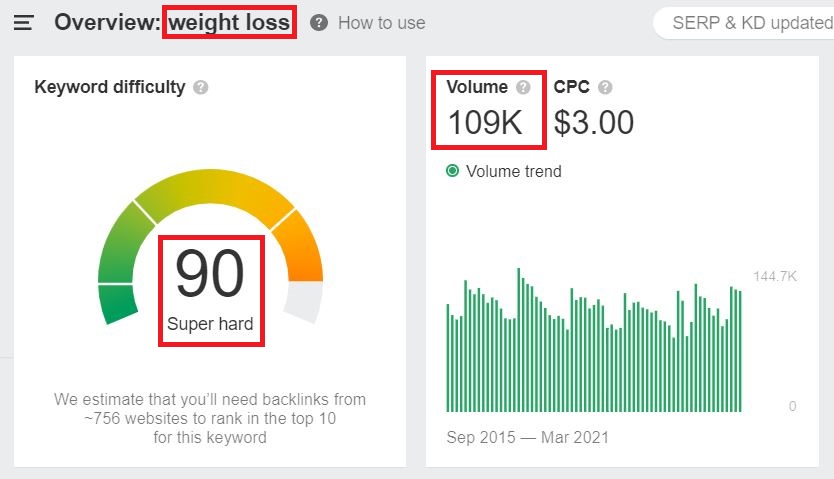
On the other hand, sure, maybe 109,000 people *are* searching for the term “weight loss” each month, but it’s got a Keyword Difficulty of 90, aka “Super Hard”.
Trying to rank for broad, saturated terms like “weight loss” is a terrible idea. There’s simply too much competition.
If you’re in a position to pay for outside help, the most useful investment we’d recommend is to hire a content writer to review and edit your work for clarity.
How to Narrow Down Your Topics
Does high competition mean you can’t succeed in the weight loss industry, though? Absolutely not.
Just because you can’t rank for the term “weight loss” doesn’t mean you can’t find a more specific opportunity.
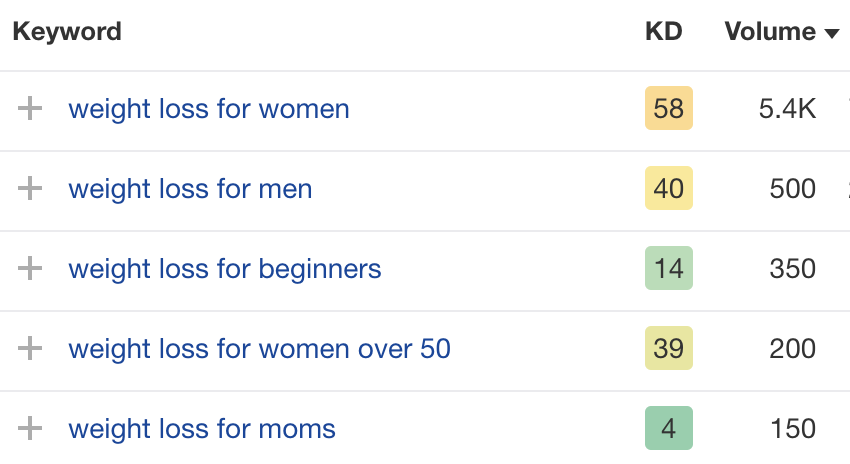
Notice that the more specific your topic, the fewer monthly searches (volume) but the less competition (KD).
Knowing how to identify terms people are looking for and searches you could rank for gives you an enormous advantage.
Identify What You Can Rank For
Get comfortable with the idea that every article you’ll ever find on page 1 of Google is, in fact, targeting that search and deserves to be ranked where it is.
It’s not enough that there’s a high demand for a keyword.
If there is a lot of competition for it, only those with a strong, established reputation will stand a chance. If you’re a new site you’ll need to target opportunities with low levels of competition.
This might mean going after terms that only get searched a couple of hundred times per month, compared to a larger site that’s able to rank for searches with tens of thousands.
Pro Tip:
Even if you’re a smaller (or brand new) site, if you write 10 articles that bring in 100 visits per month, that’s still 1,000 visits. It adds up.
Many successful sites out there focus on publishing a high amount of articles. Even if most of them only bring in 10 or 12 visits per month, because they’ve got so many articles they still receive a high amount of total traffic.
As your site grows and becomes more authoritative, you’ll begin to be able to rank for more and more challenging terms.
How to Do Keyword Research
You can write the best think piece the world has ever seen, but if it’s not optimized so that Google knows what it’s about, it’ll only ever be found by the people you share it with and almost never by a stranger doing an organic search on their own.
That’s why understanding what’s easy vs what’s difficult to rank for is so important.
It can help you decide what to focus on depending on how established your site is.
If you’d like to learn keyword research for a marketing funnel yourself, we recommend looking into tools like Ahrefs (what we’re using in these examples), SEMRush , and Moz for the best, most useful data. They’re admittedly expensive and there’s a learning curve, however.
Shameless plug: We know how to use these tools well. Hire us for keyword research services to get everything you’d ever need from them for $499. We’ll do all the work and teach you how to interpret the data going forward. It’s like a cheat code for growing your website’s traffic.
Determining the Strategy For Your Site
Quick! What’s more valuable? 100,000 monthly random visitors or 100 highly motivated rich visitors ready to spend money?
Would you rather build a brand everyone knows or just a small group of specially selected humans?
Like all businesses, your website requires a strategy.
It’s no different than physical shopping experiences in the real world (imagine a flea market vendor vs Bed Bath and Beyond vs the Ferrari dealership).
They’re all vendors; just with different markets and strategies.
Similarly, there are 3 main types of web traffic you’ll find websites prioritizing, each with a different business strategy.
Before you plan your content, it’s important to decide which direction you intend to go.
The 3 Types of Monetizable Traffic
1. General Traffic
Example: BoingBoing.net
Monetize Via: Ads, Affiliate Posts

Pros: Easy to get lots of traffic to. Doesn’t need a lot of strategy. Can focus on breaking trends and topics. Just focus on low-difficulty keywords and write lots of SEO-optimized articles.
If you just want to write (or have a team of writers) and not pick a niche subject, this can be quite lucrative and fun.
Cons: It might take a while to start to see results. And you’ll need to continuously put out lots of content at a high volume.
Google likes to know exactly what a site is about before ranking it and has begun to heavily emphasize the importance of subject matter experts.
Think:
What if a regular person were to write an article about how to save someone having a heart attack?
There could be deadly consequences if Google ranked them over advice from a professional doctor.
This doesn’t mean you can’t have similar success as Boing Boing (above) — you’ll just have to put out a lot of high-quality content consistently that keeps users engaged, sharing, and returning.
It’s the only way to show that you’re not just a low-quality content farm.
2. Niche Traffic
Example: Sprudge.com (a coffee industry publication)
Monetize Via: Industry sponsorships, paid promotions, ads, affiliate posts, merch
Pros: Write about whatever topic you want, as long as it’s in that industry and you can rank for it.
Google will give you a boost because you’re obviously dedicated to informing people about this subject and this subject alone.
You can eventually sell your site on flippa.com if you get tired of it.
Cons: You’re tied to an industry for the long term. If that industry fails, or you get tired of the subject, you’re out of luck.
Might be hard to reinvent yourself down the line if your entire reputation rests on a certain subject.
3. Product-Specific Traffic
Example: Products & Services, SaaS Businesses, Content Marketers, Thought Leaders
Monetize Via: Subscriptions, Courses, eBooks, Sales of Products and Services
Pros: Unlimited earning potential. This is the type of site that can make big-time company money and be more of a “real business” than a hobby.
Product-specific traffic is highly targeted, allowing you to sell to your customers directly. In general, they’re people with a problem to solve, and you want them to see your product or service as the solution.
Cons: Has a steeper learning curve, requires a marketing funnel, and can take longer to see results.
Plus, these niches are often more congested. Usually, there are bigger names to compete with and you’ll need to differentiate yourself.
Advice:
Technically, you could make a site with both “Niche Traffic” and “Product-Specific” angles (ie. you could sell a product and also monetize by allowing industry partners to advertise).
However, we don’t recommend it. It creates an unfamiliar user experience and the ads will distract from your goals of selling to your audience directly.
How to Plan for Each Phase of Your Marketing Funnel
If you’re selling anything at all (including digital or physical products), listen up!
The typical online buyer goes through the process of…
Awareness
Buyer searches: “why does my back hurt?”
Finds solution: “5 Ways to Relieve Back Pain,” which suggests that “maybe you need a new bed!”
Interest
Buyer searches: “best beds for back pain”
Finds solution: “The Best Beds for Back Pain for Every Budget,” which positions Casper and Tuft & Needle as the best options
Consideration
Buyer searches: “Casper vs Tuft & Needle”
Finds solution: “An In-Depth Review of Casper vs Tuft & Needle Beds,” which confirms that Casper is the best bed for back pain
Conversion
Buyer searches: “Casper Discount” or “Casper Free Shipping”
Finds solution: “Casper Memorial Day Sale! 20% off Plus Free Shipping! 24 hours only!”
Nobody will ever become a customer if they haven’t heard of you first.
The more you appear on someone’s radar, the more likely they are to begin to consider you as a solution to their problem and convert into a customer.
This process is called a marketing funnel because, visually, it looks… well, like a funnel.
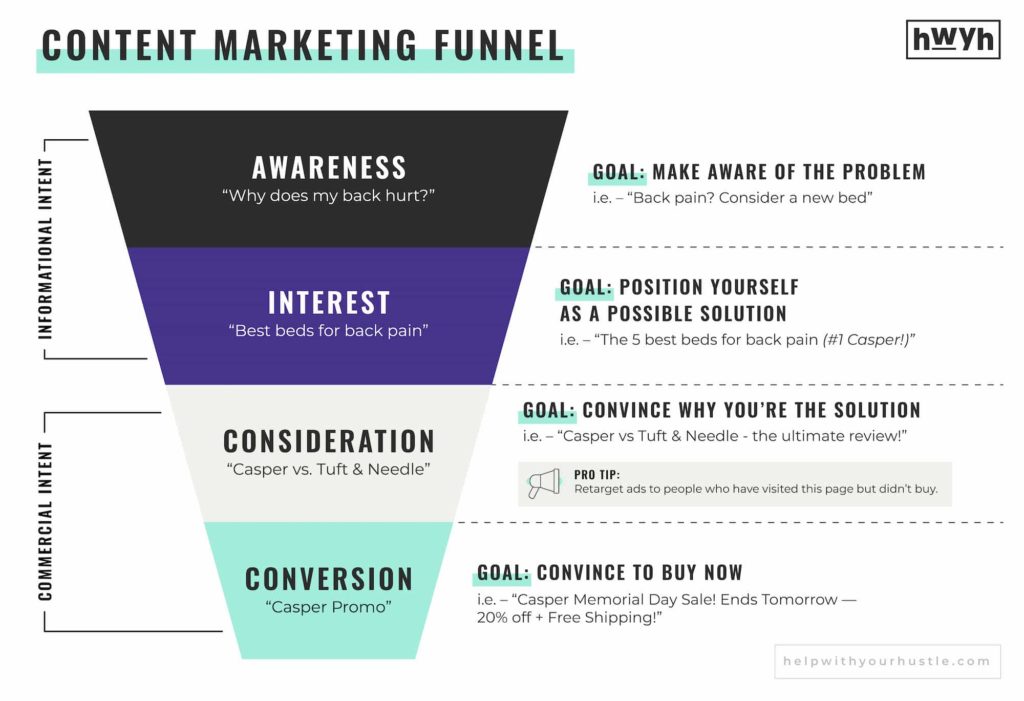
Pay attention to how the 4 articles in the above Casper examples are written to catch potential customers at every step of their buyer’s journey.
Remember: People turn to Google when they have problems. Aim to meet them where they are and position yourself as the best solution.
Advice:
Technically you could catch someone in the Awareness stage and walk them through each phase linearly, however often that won’t be the case.
For all you know, they’ve been considering this problem for years, or they heard about you via word of mouth and are ready to buy now.
Treat every piece of content in your marketing funnel independently of one another.
If your strategy prioritizes highly qualified traffic, you may choose to skip creating top-of-funnel content altogether, focusing solely on potential customers.
If your strategy prioritizes “as much traffic as possible”, maybe consider just creating tons of informational content that’s easy to rank for and watch those traffic numbers begin to grow.
Keywords Within the Content Marketing Funnel
You can tell where someone is at in their buyer’s journey by what they’re searching for.
Someone asking Google “why does my back hurt?” is much further away from making a purchase than someone searching “Casper free shipping”.
In general, you’ll attract more traffic from Top of Funnel content and less traffic from the bottom. After all, more people are looking for tips on a good night’s rest than buying a new Casper mattress.
1. Top and Top-Middle of Funnel – Awareness and Interest
For the top two steps of the marketing funnel, target keywords that cast a wide net and will drive the most traffic to your site.
Almost nobody in this part of the funnel is looking to spend money. They’re simply looking for information.
There are two ways of going about Top of Funnel content:
- Find questions and problems that your target audience might have that you’re in a position to solve. Then, create useful, share-worthy articles that present you as a trusted resource.
- Target low-hanging fruit keywords with low difficulty to drive brand awareness and get your name, logo, and colors in front of the most people possible. Get in front of their eyes a dozen times and they’ll begin to associate your brand with being the solution they can turn to.
We buy from people we know, like, and trust. To get people to buy from you, you need to get in front of them, be genuinely helpful, and solve their problems.
Advice:
Resist the urge to hard sell with this content and avoid coming across as an impersonal salesperson.
To capture a percentage of leads from this stage in your funnel, you might consider a (subtle) pop-up that offers a better solution than just what’s available on the current page.
For example, if it’s an article on “how to do keyword research for a marketing funnel” the reader may be interested in a free 5-day intro to SEO course. ????
Because so many more searches are informational (compared to transactional searches at the bottom of the marketing funnel), awareness terms are what you should be trying to rank for if your goal is “as much traffic as possible”.
2. Bottom-Middle of Funnel – Consideration
Continuing the example of how a “why does my back hurt?” search can turn into a mattress sale, even if 10,000 people search that term, only a small percentage will ever become customers.
Some will see a chiropractor, some will wake up tomorrow and their back pain will have gone away.
But the percentage who have accepted the advice to buy a new mattress will start a *new* search.
At this point, they’re considering their options, so their searches often include words like “best” or “top” and will include specific modifiers (ex: “for back pain”).
For example, they might search “best mattresses for back pain” or “top mattresses back pain” or “back pain best mattress”.
Or maybe they’ve heard of a few brands already so their searches might include words like “vs” or “review”.
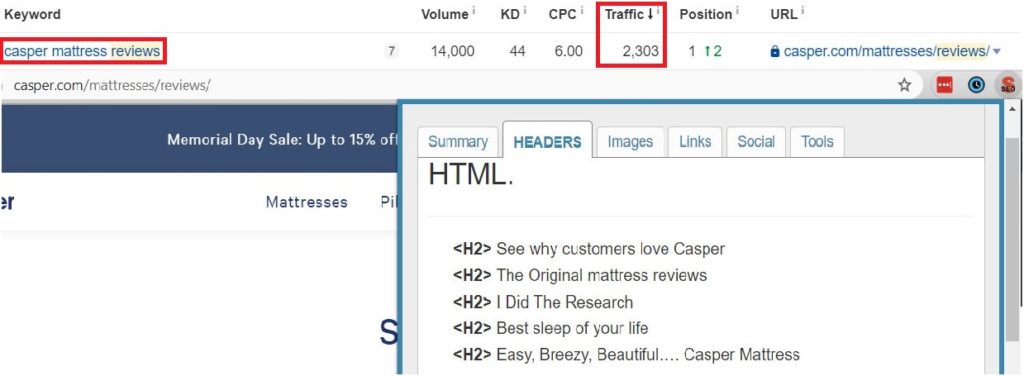
Once the buyer realizes that a new mattress is a solution for their back pain, naturally the next step is to figure out which one is best for them.
That’s why they often search for terms like “Casper vs Tuft & Needle” or “Casper Tuft & Needle back pain.”
As a marketer, this is what you pay attention to.
These are the searches of people who are considering spending money and need help to make up their minds about which solution serves their needs best.
What happens if you can get an article in front of their eyes that convincingly suggests your product is superior to your competitors? You’ll win the hearts and dollars of happy new customers.
4. Bottom of Funnel – Conversion
Voila.
By this point, the buyer has identified their problem, learned exactly what the solution is, determined that you were it, and decided to give you their money.
What do they do next?
Most people at this point look to save a few bucks. You’d be wise to make it easy for them.

Conclusion
Once you have a strategy for your website, all that’s left is to focus on the kind of content that makes the most sense FOR YOU going forward.
Instead of throwing darts in the dark and hoping for the best, design a marketing funnel so you’ll know that what you’re doing has a reason behind it. You can be confident that you’re on the right track.
In tomorrow’s lesson, we’ll learn how to optimize content that gets discovered. See you then!
